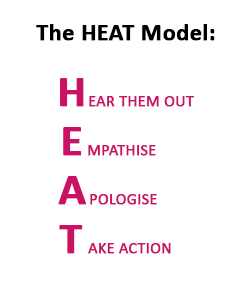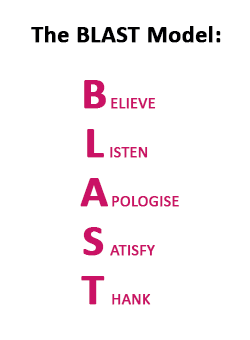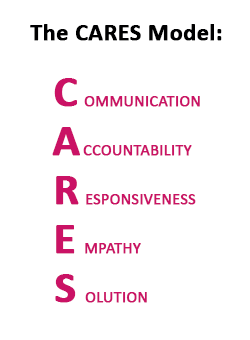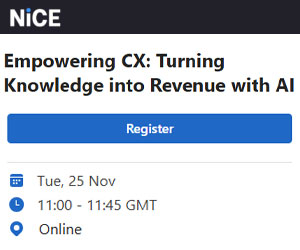We explore seven contact centre coaching models that will help to drive customer engagement.
Why Are Customer Engagement Models Helpful?
Customer engagement is a broad topic. When coaching advisors to do it well, it’s helpful to give them a framework that sticks in their minds.

“Asking people to do anything behavioural is tricky because, invariably, there will be inconsistency in how people perceive your instructions,” says Nick Drake-Knight, Founder of Continue & Begin.
So, keep the coaching as simple as possible. Employ a model that has very few component parts. After all, advisors will struggle when tasked with remembering 20 different things at once. Instead, the customer should be the central focus.
A skeleton approach is, therefore, a much better coaching tactic. Each of the following seven models – used in contact centres across the UK – provides such a structure.
Coach them and run roleplays and soon advisors will be ready to take to the phones and emotionally engage customers.
1. The Emotional Driver Model
This model follows the principle that when getting in touch with the contact centre customer behaviour is driven by one of the following two feelings:
- An urge to move away from discomfort (or potential discomfort)
- An urge to feel good
Explaining the model, Nick Drake-Knight says: “We’re all domesticated mammals. What do all mammals want? Well, they want to feel good and avoid feeling bad. All human behaviour is initiated by either one of these emotions.”
The theory is that if an advisor can identify which primary driver is at play and change their communication style, the chances of creating emotional engagement increase significantly.
For example, if the customer is angry and clearly in “discomfort”, demonstrate empathy. If the customer conveys a positive, vibrant tone, offer them a compliment. Simple but effective.
2. Every Customer Wants
The “Every Customer Wants” model – developed by Nick – works on the premise that there are three “deliverables” that are important to all customers. He defines these as:
- Understand me – Get inside my world, discover what’s important to me. Take care to listen to my story, put yourself in my shoes, see things from my perspective. Understand what I want and what I don’t want.
- Add value for me – Help me by providing something of value, a product or service. Make a difference in my life, even if it’s a small thing. Offer me help to make my life more comfortable.
- Make it easy for me – Keep this simple, minimize my effort and make it hassle-free.
To improve emotional engagement, share each of these ideas with the team as part of a workshop. Ask them: what, generally, can you do in your role to meet each “need”?
With all of the ideas gathered, create a small list of definitive actions against each category that advisors can practically put into practice.
Also, it can work well to run such an initiative with leaders and managers. In doing so, they can pinpoint ideas for supporting advisors in achieving each of these three key aims.
3. The Three Vs
A different approach to meeting fundamental customer needs starts with asking advisors to focus on the 3Vs of emotionally engaging customer service. These are:
- Visible – Listen carefully to customers, give them verbal nods and reflect their ideas back, demonstrating a clear understanding of what they said. Then, get personal.
- Validated – Acknowledge and validate the customer’s feelings. Tell them that they did the right thing by calling, and when they express emotion, be comforting.
- Valued – Encourage advisors to show empathy, take ownership and reaffirm to the customer that they’re there to help. Customers feel good thinking that they have a personal helper within the business.

Helen Pettifer, Director of Helen Pettifer Training – who put forward this model – also suggests taking it beyond the confines of a call and into the contact centre’s value system.
“Build your own set of actions against each V – so it becomes practical to use – and encourage advisors to demonstrate these behaviours in conversations with colleagues too,” says Helen.
“The goal is to connect with people. Instead of fixating on customer experience, focus on the human experience. This model is great for doing just that.”
Eventually, if advisors constantly get into a rhythm of demonstrating the three Vs, it will become natural and more meaningful conversations will arise.
4. The Human–Business Model
Essentially, an advisor aims to achieve two goals when answering a query. These are to improve customer emotion and resolve the problem. In other words, they need to meet human and business needs.
Throughout the call, the advisor will switch between the human and business element, covering both bases. The diagram below highlights this principle.

As the call progresses, a well-trained advisor will constantly alternate their focus between the solution and the customer. In doing so, they may consider:
- How does the customer feel about the progress of the conversation?
- Are they following the conversation?
- Does their tone suggest that it would be helpful to repeat the information?
“By moving back up to the human element, the advisor can address the customer’s emotions, connect with them and build rapport,” says Helen Pettifer.
Interestingly, the model also encourages advisors to start and close the call on the human element.
Offering a warm, friendly greeting, while also thanking the customer at the end of the call, is fundamental to getting this right.
Want to send your customers off with smiles on their faces? Here is our guide to wrapping up the call as positively as possible: The Best Call-Closing Statements
5. HEAT

Emotional customers present a unique chance to create a memorable experience.
Even if that emotion is anger, advisors can turn that negative into a positive through effective customer service.
The HEAT model provides the perfect path for doing just that. Coaching this approach takes the sting out of difficult calls, as advisors have a simple process to follow – as highlighted below.
Hear Them Out
Ask an open question and let the customer vent. To move on, they need to get all that ill-feeling off their chest.
Remind advisors not to take criticism personally and get defensive. Just listen and use verbal nods so that the customer feels as though they’re being listened to.
Empathize
After listening to the customer, advisors will know what has riled them up. To demonstrate empathy, advisors can tailor generic empathy statements to the customer’s situation.
A warm tone of voice must also accompany these phrases. To coach both, share call recordings where an advisor demonstrates empathy well.
Apologize
Apologize sincerely. No half-apologies such as “I’m sorry you feel that way,” or “I’m sorry for the inconvenience.” Personalize the apology to the situation.
If a customer’s delivery was late say: “I’m sorry that your delivery was late.” It’s not rocket science, but it’s surprising how many contact centres get this wrong.
Take Action
Straight after the apology, focus away from the negative and towards the positive. Encourage advisors to tell customers how they are going to solve the problem.
Fill customers up with the belief that the end is in sight. Use techniques like signposting, alongside an energetic tone, to show them that no time is being wasted.
Of course, there any many other best practices for handling difficult phone calls, such as acknowledging the problem, reassuring the customer and training self-regulation. However, HEAT provides the perfect starting point.
Once advisors feel comfortable with this model, start adding to it – bit by bit. Advisors will gradually become experts in defusing situations and emotionally engaging with customers.
Uncover lots more top tips for difficult phone calls in our article: How to Handle an Angry Customer
6. BLAST

Another model that works well for handling customer complaints is named BLAST. Again, each letter represents an action that will help to increase emotional engagement:
Believe
Sure, the customer may be exaggerating or perhaps even lying about what happened. When advisors realize this, it can cloud their judgement.
What’s important is that the customer believes that the organization has wronged them. So, refrain from questioning them, show support and stick to the facts.
Listen
Stay attentive, make notes of important points and repeat the nuts and bolts of what the customer has said back to them.
Doing so demonstrates that the advisor was listening carefully, which reassures the customer. Plus, if the advisor misses anything, the customer can fill the gaps.
Apologize
Complaining customers expect an apology, even if the company did nothing wrong. Of course, in these situations, it’s easy to offer a non-apology.
Yet, this will only create tension. Instead, simply say: “I’m sorry that we’ve caused you to feel…” and then insert the emotion that the customer expressed.
Satisfy
Crack on with the resolution process. For common complaints, advisors should have a clear process to follow. When the complaint is more obscure, encourage advisors to ask: what can I do to make this right for you? Then, the team may play the judge of what is fair.
Of course, this requires empowerment, but it provides an opportunity to satisfy customers.
Thank
Stay courteous and thank the customer for their feedback. Tell them that the business is always open to improvement ideas and will pass on their thoughts to management to prevent such a problem from cropping up again.
Alongside these five key points, there are many more great ways to improve complaint handling. Some of which may stem from analysing successfully handled complaints.
However, the BLAST approach provides a simple structure which is easy to follow. When using it, advisors can immediately feel confident in dealing with complaints and emotionally engaging with customers – straight after induction training.
7. CARES

Run-of-the-mill conversations are not going to thrill customers. Yet showing attentiveness and respect for the customer’s time will provide them with a positive feeling. Over time, this can create emotional engagement.
So, for those simple, everyday conversations, stick to the CARES approach. Coaching this to advisors, by taking on board the following advice, will enable the team to exceed expectations.
Communication
At the start of the call, clearly communicate the process for handling the query.
Tell customers, step by step, what will happen and what information they need to have handy. In doing so, the advisor takes ownership and demonstrates to the customer that they’re in safe hands.
Accountability
Continue to build up customer confidence by making a commitment. Once again, this enables the advisor to take ownership and builds trust.
So, after setting the customer’s expectations at the beginning of the call, use a statement such as: “In a few minutes, I’ll have this solved for you,” and build accountability.
Responsiveness
After each step of the problem-solving process, summarize what has been accomplished. Doing so will build the customer’s faith that a good solution is forthcoming.
Also, on the topic of responsiveness, coach advisors to bridge periods of silence on the call to build rapport, keep the customer in the loop and increase engagement.
Empathy
Thank the customer for bearing with the process and acknowledge that they would rather be somewhere else. Showing such empathy will draw the customer out of their shell and increase their emotional engagement with the advisor.
Solution
Finish by presenting the solution and summarizing the phone. Say what happens next, ask the customer whether they have another query and finish up with a courteous sign-off.
For complex calls, there are better approaches to increase emotional engagement. These will include questioning techniques, such as the funnel effect.
But when there’s a simple framework for answering the call, follow the CARES model and offer good, efficient customer service that will knock the customer’s socks off.
Final Thoughts
Models are a great way to coach advisors. They provide a simple structure that the team will grow increasingly confident in following.
Each of the models shared above is a great example. Designed to develop emotional engagement with customers, they are also easy to build into training programmes.
Just start small. Coach in one model and track its progress. Then, if it proves successful, bring in others and – over time – steadily improve emotional engagement with customers.
Discover many more ideas for getting customer emotion right in the contact centre by checking out the following pieces of popular content:
- How to Measure Customer Emotion
- Creating Memorable Customer Experiences With Emotional Intelligence
- Podcast: How Can You Use Customer Emotions to Your Advantage?
Author: Robyn Coppell
Reviewed by: Hannah Swankie
Published On: 28th Sep 2022 - Last modified: 21st Oct 2025
Read more about - Customer Service Strategy, Customer Engagement, Customer Experience (CX), Helen Pettifer, Nick Drake-Knight, Service Strategy








































